
Manage cookies and website data
Websites often store cookies and other data on your Mac. This data may include information that you have provided, such as your name, email address, and preferences. This data helps websites identify you when you return so the site can provide services for you and show information that might be of interest to you.
By default, Safari accepts cookies and website data only from websites you visit. This helps prevent certain advertisers from storing data on your Mac. You can change options in Safari preferences so that Safari always accepts or always blocks cookies and other website data.
Open Safari for me
Important: Changing your cookie preferences or removing cookies and website data in Safari may change or remove them in other apps, including Dashboard.
Choose Safari > Preferences, click Privacy, then do any of the following:
Change which cookies and website data are accepted: Select a “Cookies and website data” option:
Always block: Safari doesn’t let any websites, third parties, or advertisers store cookies and other data on your Mac. This may prevent some websites from working properly.
Allow from current website only: Safari accepts cookies and website data only from the website you’re currently visiting. Websites often have embedded content from other sources. Safari does not allow these third parties to store or access cookies or other data.
Allow from websites I visit: Safari accepts cookies and website data only from websites you visit. Safari uses your existing cookies to determine whether you have visited a website before. Selecting this option helps prevent websites that have embedded content in other websites you browse from storing cookies and data on your Mac.
Always allow: Safari lets all websites, third parties, and advertisers store cookies and other data on your Mac.
Remove stored cookies and data: Click Manage Website Data, select one or more websites, then click Remove or Remove All.
Removing the data may reduce tracking, but may also log you out of websites or change website behavior.
See which websites store cookies or data: Click Manage Website Data.
Change how often websites ask to use your location information: Select a “Website use of location services” option:
Prompt for each website once each day: Safari prompts you once each day for each website you visit that requests use of location services.
Prompt for each website one time only: Safari only prompts you once for each website you visit that requests use of location services.
Deny without prompting: All websites are denied access to location services and Safari does not prompt you.
Ask websites not to track you: Some websites keep track of your browsing activities when they serve you content, which enables them to tailor what they present to you. You can have Safari ask sites and their third party content providers (including advertisers) not to track you.
With this option turned on, each time Safari fetches content from a website, Safari adds a request not to track you, but it’s up to the website to honor this request.
- Apple Watch
- Accessories
- Digital Magazine – Subscribe
- Digital Magazine – Info
- Smart Answers
- New iPad Air
- iPad mini 7
- Next Mac Pro
- Best Mac antivirus
- Best Mac VPN
When you purchase through links in our articles, we may earn a small commission. This doesn't affect our editorial independence .
How to clear Safari’s cache and cookies on Mac

There are a handful of situations when clearing Safari’s cookies or cache–one of the places where Safari stores website data to avoid having to download it afresh each time you access a site–can help improve your browsing experience.
The first is when websites simply stop working when you access them on Safari. Perhaps Facebook stops updating with new posts, for example, or the images on a site don’t appear as they should. If this happens, it’s likely the cache has become corrupted.
Alternatively, if you find that personal info automatically completed on sites isn’t correct, deleting cookies can help. These are small files that sites use to save data about you and what you do on the site.
Even if none of these problems affect you, periodically cleaning browser data can help protect your privacy from snoops who want to discover what you’ve been up to online. In this article, therefore, we explain how to clear Safari’s cache and cookies on Mac.
We also have an article that explains How to clear cache on a Mac.
How to clear Safari cookies and cache for websites
Cleaning cookies and the cache data for individual sites can be done via Safari’s Settings/Preferences.
- Open Safari
- Click on Safari in the menu at the top of the screen.
- Click on Settings or Preferences (depending on the version of macOS you are running).
- Go to the Privacy tab.
- Click on Manage Website Data…
- Choose Remove All or select websites individually to remove.
After the data is loaded you’ll probably see a long list of websites. You can choose to Remove All or just select individual websites you want to remove from this list. If you want to select a number of different sites you can click on one and then press and hold the Command key to select a second, third or fourth and so on. We recommend that you don’t select hundreds this way – it’s better to delete in batches just in case you have to start over.
If you would prefer to select all and then deselect the ones you want to keep you can do so. Use Command + A to select all, then press and hold Command while clicking on any website you are happy to keep in this list. Just click Remove afterwards, not Done, as that will just undo all your hard work.
There’s a search field you can use to track down individual sites.
Bear in mind that deleting cookies might remove autocompleted login usernames and passwords for sites, and will almost certainly log you out of that site if you’ve configured it to automatically log in each time you visit.

How to clear Safari cache
The hidden Safari Developer menu can be used to clear just the cache, leaving cookies and the browser history in place. This is a very useful diagnostic step to take before removing those two items if a website behaves badly.
If you just want to clear all your cache you can do so by following these steps:
- Open Safari.
- Click on Safari in menu bar at top of screen.
- Click on Settings/Preferences (depending on the version of macOS you are running).
- Click on the Advanced tab.
- Check the box beside Show Develop Menu in Menu Bar.
- Now there will be a new Develop tab in the menu at the top of your screen. Click on this.
- Click on Empty Caches.
Alternatively click on Option/Alt + Command + E.
Close any open Safari windows and select Empty Caches on the Develop menu. Then click File > New Window to start Safari with a clean cache.

How to remove autocomplete data from AutoFill
Safari’s AutoFill tool can fill in username and password details on websites as well as credit card details and other elements like your address and email details.
This can be really useful, but it can also be annoying if the data it fills in is incorrect or out of context. It’s also a problem when AutoFill helpfully enters old or incorrect passwords or emails and addresses.
You can change this data, or delete it by following these steps:
- Click on Safari.
- Click on Settings/Preferences.
- Choose the AutoFill tab.
- Here you can edit contact information, usernames and passwords, credit cards and other data. Click on Edit beside the category you want access to.
- You’ll need to enter your password or use Touch ID to gain access.
Delete incorrect data: If you are finding that Safari is autofilling incorrect data about you–your address, for example–click Edit beside Using information from my contacts. This will open up your Contacts app. Your card will be at the top or under My Card. You can add and amend data about you here.

Delete incorrect passwords and site logins: If you wanted to delete incorrect passwords, for example, you can just click on the Passwords tab. If you know which password you want to remove search for the website or service and then find the older password option (if there is more than one) and select it and then click on the – below the column to remove it. You can then select Delete Password. If that means there is no password saved for that website, you can then recreate the entry for the site by clicking the Add button. You’ll first need to provide the URL of the site (that is, something like https://facebook.com ), and then type the username and password alongside (hit the Tab key to move from field to field).
See: How to autofill passwords, bank cards, names and addresses for more.

Delete logins and passwords system-wide
Pruning site logins can also be done via the Keychain Access app, which you’ll find in the Utilities folder of the Applications list in Finder, although you should be very careful using this app because it pretty much controls the entire security operation of your Mac! However, by removing errant username and password entries here you’ll stop virtually all of your Mac apps using them, and not just Safari.
Just type the name of the site into the Search field, and look in the list of results for entries of the kind Web Form Password. Right-click the entry and select Delete.

If you want to delete your Chrome or Firefox cache, cookies or browsing history read: How to delete your Mac browsing history . For alternative web browsers take a look at: Best web browser for Mac.
How to Block Cookies in Safari
Websites use browser cookies to store information and retrieve information about you each time you visit. Sometimes this is helpful, such as cookies that save your shopping cart information between sessions, but cookies also allow advertisers to profile you and try to get you to spend more money. If you want to control your privacy, you can block all cookies or just some of them in Safari.
Block Cookies in Safari on the Mac
1. Select Preferences from the Safari menu or use the Command+, keyboard shortcut (hold down the Command key and the comma key at the same time).

2. Go to the Privacy tab.

3. Choose how you want Safari to treat cookies. By default, Safari allows cookies from the sites you visit, but prevents third-party content that might be embedded in those sites from storing cookies on your computer. Your other options are:
- Always block: No cookies are allowed to be stored on your Mac. Keep in mind this option might prevent some sites from working properly.
- Allow from current site only: Only the current site you're visiting will be allowed to store cookies.
- Always allow: All websites, third parties, and advertisers can store cookies on your Mac.

4. Close the Preferences window when you are done. Your settings will apply to all future website browsing.
One setting you might also want to change in Safari's Preference menu is website tracking. Check the "Ask websites not to track me" option to tell sites and their third-party content providers not to keep track of your browsing activities using tools other than cookies. Safari will send a "do not track" request when you visit the site, but it's up to the website owner to comply.
Block Cookies in Safari in iOS
You can also block cookies on your iPhone or iPad to stop sites from tracking your mobile browsing activity. Here's how to do that in iOS 8 or later.
Stay in the know with Laptop Mag
Get our in-depth reviews, helpful tips, great deals, and the biggest news stories delivered to your inbox.
1. Open the Settings app, tap Safari, and tap Block Cookies.

2. Select your cookies preference. The options are the same as those for OS X.
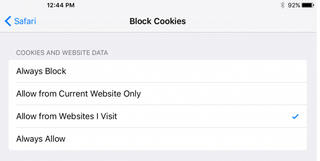
If you're using iOS 7 or earlier, your options will be "Never," "From third parties and advertisers," or "Always."
- How to Search for Text Within a Web Page in Safari
- How to Restore Recently Closed Tabs and Windows in Safari
- How to Use Private Browsing in Safari
How to convert PDF to JPG, PNG, or TIFF
How to add Outlook Calendar to Google Calendar
A tale of two flops: What Apple Vision Pro can learn from Google and Nintendo failures
Most Popular
- 2 Razer Viper V3 Pro vs. Alienware Pro Wireless: Which gaming mouse is better?
- 3 3 Windows 11 taskbar tricks to change up your desktop
- 4 The 9 most important factors for buying a gaming laptop
- 5 Windows 12 isn't Microsoft's only missing operating system
- PRO Courses Guides New Tech Help Pro Expert Videos About wikiHow Pro Upgrade Sign In
- EDIT Edit this Article
- EXPLORE Tech Help Pro About Us Random Article Quizzes Request a New Article Community Dashboard This Or That Game Popular Categories Arts and Entertainment Artwork Books Movies Computers and Electronics Computers Phone Skills Technology Hacks Health Men's Health Mental Health Women's Health Relationships Dating Love Relationship Issues Hobbies and Crafts Crafts Drawing Games Education & Communication Communication Skills Personal Development Studying Personal Care and Style Fashion Hair Care Personal Hygiene Youth Personal Care School Stuff Dating All Categories Arts and Entertainment Finance and Business Home and Garden Relationship Quizzes Cars & Other Vehicles Food and Entertaining Personal Care and Style Sports and Fitness Computers and Electronics Health Pets and Animals Travel Education & Communication Hobbies and Crafts Philosophy and Religion Work World Family Life Holidays and Traditions Relationships Youth
- Browse Articles
- Learn Something New
- Quizzes Hot
- This Or That Game New
- Train Your Brain
- Explore More
- Support wikiHow
- About wikiHow
- Log in / Sign up
- Computers and Electronics
- Internet Browsers
- Safari Browser
How to Enable Cookies in Safari
Last Updated: March 16, 2024 Tested
This article was written by Luigi Oppido and by wikiHow staff writer, Nicole Levine, MFA . Luigi Oppido is the Owner and Operator of Pleasure Point Computers in Santa Cruz, California. Luigi has over 25 years of experience in general computer repair, data recovery, virus removal, and upgrades. He is also the host of the Computer Man Show! broadcasted on KSQD covering central California for over two years. The wikiHow Tech Team also followed the article's instructions and verified that they work. This article has been viewed 579,844 times.
Cookies are enabled by default in Safari on your Mac, iPhone, and iPad. If the features of a certain website aren't working properly or you're getting errors about cookies, you may have disabled cookies in your settings. This wikiHow article will teach you how to allow cookies in Safari, and show you what to do if cookies aren't working properly.
Things You Should Know
- Open Safari on your Mac. Go to Safari > Preferences… > Privacy and uncheck "Block all Cookies".
- Try clearing your cookies if you are having trouble loading websites—sometimes old cookies get in the way of saving the new version of a cookie.
Enabling Cookies on a Mac

- In most cases, you'll probably want to leave a checkmark in front of this option to preserve your privacy. However, if websites aren't loading properly or you can't use the features of certain sites, you may need to enable this option.
Enabling Cookies on iPhone and iPad

- In most cases, you'll probably want to leave this switch on, as this protects your privacy. However, if websites aren't loading properly or you're unable to use features of certain sites, you can enable this option and see if it resolves the problem.
Troubleshooting

- Mac: Click the Safari menu, select Preferences , click Privacy , and then remove the checkmark from "Prevent cross-site tracking."
- iPhone/iPad: Open your Settings , tap Safari , and then toggle the "Prevent Cross-Site Tracking" switch to the Off (white) position.

- First, check to make sure private browsing is not always set to turn on—click the Safari menu, select Preferences , click General , and click the "New windows open with" menu. [6] X Research source If "A new private window" is selected, choose A new window instead.
- Then, to open a new window, just close the currently open Safari window, click the File menu, and then select New Window .
- iPhone/iPad: Open Safari and tap the overlapping squares at the bottom. [7] X Research source Tap Private at the bottom (if you see it), select (number of) Tabs , and then tap Done .

- Mac: Click the Safari menu, click Preferences , click Privacy , click Manage Website Data , and then click Remove All .
- iPhone/iPad: Open Settings , tap Safari , tap Advanced , select Website Data , and then tap Remove All Website Data . [8] X Research source
Community Q&A
- Enabling cookies can often allow you to view and have access to a larger number of websites that require cookies in order to function or display properly. Thanks Helpful 0 Not Helpful 0
- Despite their poor reputation, cookies aren't inherently malicious. Thanks Helpful 0 Not Helpful 0

You Might Also Like

- ↑ https://support.apple.com/guide/safari/manage-cookies-and-website-data-sfri11471/mac
- ↑ https://support.apple.com/en-us/105082
- ↑ https://support.ewu.edu/support/solutions/articles/10000057364-how-do-i-disable-prevent-cross-site-tracking-in-safari-
- ↑ https://support.apple.com/guide/safari/use-private-browsing-ibrw1069/mac
- ↑ https://support.apple.com/en-us/HT203036
About This Article

1. Open Safari. 2. Click the Safari menu 3. Click Preferences... . 4. Click the Privacy tab. 5. Remove the checkmark from "Block all cookies." Did this summary help you? Yes No
- Send fan mail to authors
Is this article up to date?

Featured Articles

Trending Articles

Watch Articles

- Terms of Use
- Privacy Policy
- Do Not Sell or Share My Info
- Not Selling Info
Keep up with tech in just 5 minutes a week!
How to allow cookies on your Mac to save passwords and other important information
- You can allow cookies on your Mac from Safari's Preferences page.
- Allowing cookies lets your browser save important information like passwords and search history.
- If you want to keep cookies from some sites only, you can selectively remove stored cookies by site.
Cookies are the little snippets of data used to track your internet browsing patterns, which are then stored in your computer. Many people believe that cookies are overused for targeted advertisements, which can often be labeled as "creepy ."
But cookies can actually be quite helpful. For example, cookies allow your computer to remember important information like log-in credentials so you don't always have to enter your password. Cookies also let you save items in a shopping cart when you're looking to buy something online.
If you'd like to allow cookies on your Mac's Safari web browser, here's how.
How to allow cookies on Mac in Safari
1. Open your Safari web browser.
2. On the left side of the toolbar at the very top of your screen, click Safari and select Preferences in the drop-down.
3. In Preferences, go to the Privacy tab — the icon that looks like a hand in a circle.
4. Next to Cookies and website data , make sure the box next to Block all cookies is not checked.
Unchecking Block all cookies will allow any and all cookies to be stored by websites you visit as well as third-party trackers, which are typically advertisers.
How to remove data stored by certain websites using Safari on Mac
In Mac's Safari, you can remove browsing data stored by certain websites you visit on your computer.
2. In the left side of the toolbar at the very top of your screen, click Safari and select Preferences in the drop-down.
4. Under Block all cookies , click on Manage Website Data .
5. Here you can remove information collected by certain sites by selecting a site in the list and clicking Remove at the bottom of the window. Or, you can remove information collected from all sites by clicking Remove all at the bottom of the window. Removing your cookie data might reduce the amount websites track you, but it might also log you out of certain websites.
6. Click Done in the bottom-right corner of the window when you're finished.
- Main content
Apple updates Safari’s anti-tracking tech with full third-party cookie blocking
Beating google by two years to the privacy feature.
By Nick Statt , is a Senior Producer on Decoder. Previously, he wrote about technology and gaming for Naavik, Protocol, and The Verge.
Share this story
:format(webp)/cdn.vox-cdn.com/uploads/chorus_asset/file/11477047/acastro_180604_1777_apple_wwdc_0001.jpg)
Apple on Tuesday released a major update to its Safari Intelligent Tracking Prevention (ITP), the privacy feature that allows the company’s web browser to block cookies and prevent advertisers from snooping on your web habits. According to Apple’s John Wilander, the WebKit engineer behind the feature, Safari now blocks all third-party cookies . That means that, by default, no advertiser or website is able to follow you around the internet using the commonplace tracking technology.
It’s a significant milestone for web privacy, and it puts Apple’s browser officially two whole years ahead of Chrome, after Google said in January that it would start phasing out third-party cookies but not fully until some time in 2022.
“Cookies for cross-site resources are now blocked by default across the board. This is a significant improvement for privacy since it removes any sense of exceptions or ‘a little bit of cross-site tracking is allowed,’” Wilander notes in the announcement post on the blog for WebKit, which is Apple’s in-house browser engine that powers many of its features under the hood.
Wilander notes that users might not notice a big change because ITP has been doing this more or less already. “It might seem like a bigger change than it is. But we’ve added so many restrictions to ITP since its initial release in 2017 that we are now at a place where most third-party cookies are already blocked in Safari.”
- How to use Safari’s tools to protect your privacy while browsing
- How your browser protects your privacy
- Advertisers are furious with Apple for new tracking restrictions in Safari 11
Apple first launched ITP within Safari nearly three years ago, where it immediately set a new bar for web privacy standards on both desktop and mobile by blocking some, but not all, cookies by default. Alongside the substantial privacy work of Mozilla’s Firefox, which also blocks third-party cookies by default as of last summer , Apple has been pioneering a machine learning approach to web tracking prevention that has made Safari one of the most widely used and secure web tools available.
In addition to blocking third-party cookies across the board and by default, Wilander says ITP now has safeguards against trackers using the very nature of tracking prevention as a way to keep tabs on users . He adds that the new feature set also ensures that websites and trackers can’t use login IDs to digitally fingerprint users who might otherwise be using tracking prevention or other privacy tools.
Wilander thanks Google for helping Apple improve ITP
“Full third-party cookie blocking makes sure there’s no ITP state that can be detected through cookie blocking behavior. We’d like to again thank Google for initiating this analysis through their report,” he writes, referencing Google’s research published earlier this year on ITP that revealed the possibility of using some elements of it as a fingerprint. (Apple had to disable the Do Not Track feature in Safari in 2019 for similar reasons.)
Wilander goes on to detail some other, more technical elements of the ITP update. But in general, he says Safari is again setting a new bar for web privacy that he and Apple hope other companies will follow.
“Safari continues to pave the way for privacy on the web, this time as the first mainstream browser to fully block third-party cookies by default. As far as we know, only the Tor Browser has featured full third-party cookie blocking by default before Safari, but Brave just has a few exceptions left in its blocking so in practice they are in the same good place. We know Chrome wants this behavior too and they announced that they’ll be shipping it by 2022,” he writes. “We will report on our experiences of full third-party cookie blocking to the privacy groups in W3C to help other browsers take the leap.”
In the first Autonomous Racing League race, the struggle was real
The walls of apple’s garden are tumbling down, the apple vision pro’s ebay prices are making me sad, the oled ipad pro could launch with an m4 chip, they turned cattle ranches into tropical forest — then climate change hit.
More from Policy
:format(webp)/cdn.vox-cdn.com/uploads/chorus_asset/file/24814378/STK450_European_Union_02.jpg)
The EU’s tough new moderation rules are about to cover a lot more of the internet
:format(webp)/cdn.vox-cdn.com/uploads/chorus_asset/file/23932923/acastro_STK108__01.jpg)
Apple unbanned Epic so it can make an iOS games store in the EU
:format(webp)/cdn.vox-cdn.com/uploads/chorus_asset/file/22512651/acastro_210512_1777_deepfake_0003.jpg)
New bill would let defendants inspect algorithms used against them in court
:format(webp)/cdn.vox-cdn.com/uploads/chorus_asset/file/25287678/1976469308.jpg)
Kids Online Safety Act gains enough supporters to pass the Senate
- Get One: Tornado Alert Apps
- The Best Tech Gifts Under $100
How to Enable and Allow Cookies on Mac
Unblock cookies on Safari, Chrome, and Firefox for Mac
:max_bytes(150000):strip_icc():format(webp)/BrennaMiles-212580-7ae6e42429d144bf8652a7a35a2fcc4c.jpg)
- The University of Phoenix
:max_bytes(150000):strip_icc():format(webp)/image-5e6611aebe974bb7886a24b5070c834f.jpg)
What to Know:
- Cookies store your personal preferences in web browsers so that the browser doesn't waste time requesting the information multiple times.
- Enabling cookies on Mac lets your browser store reusable data, such as email addresses or saved shopping cart items.
This article explains how to set up cookies in Safari, Chrome, and Firefox.
How to Enable Cookies in Safari
Safari is Apple's default browser on all Mac computers and iOS devices. To enable cookies on your Mac, start by opening Safari.
Click Safari in the menu bar and select Preferences to open the Safari General preferences screen.
Click the Privacy tab to open the Safari Privacy settings.
Clear the check mark in front of Block all cookies to enable cookies in Safari.
Want to remove specific websites from the list of websites storing your information? Select Manage Website Data and remove them.
Close Preferences to save your changes.
How to Enable Cookies in Chrome
Chrome is a web browser created by Google. To enable cookies in Chrome, start by opening the Chrome browser on your Mac.
Click the three dots at the far right side of your screen.
Click Settings in the drop-down menu.
Select Privacy and security in the left sidebar.
Select Cookies and other site data .
Click the Allow all cookies button to turn it on. It button contains a blue bullet when it is turned on.
You can also choose to keep your data only until you close your browser. To do this, move the slider next to Clear cookies and site data when you close all windows to the On position.
- How to Enable Cookies in Firefox
Firefox is an open-source web browser offered by Mozilla. Open Firefox on your Mac to start changing your cookie settings.
In Firefox, click the three horizontal lines at the top right corner of the screen.
Select Settings in the drop-down menu.
Click Privacy & Security in the left sidebar.
Firefox blocks cookies by default. To enable them, select the Custom section to expand it. Remove the check from in front of Cookies to unblock cookies in Firefox.
Get the Latest Tech News Delivered Every Day
- How to Enable Cookies in Your Browser
- How to Delete Cookies in Every Major Browser
- 4 Ways of Transferring Files From Android to Mac
- How to Turn Off AdBlock on Mac
- How to Enable Cookies on an iPad
- How to Enable Cookies on Android
- How to Clear Cookies for a Specific Site
- What Is Safari?
- How to Delete and Clear Cookies on an iPhone
- How to Change the Default Search Engine in Chrome for iOS
- How to Delete Downloads on Mac
- The Top 10 Internet Browsers for 2024
- How to Increase Web Browser Security
- How to Turn Off a Pop-Up Blocker on a Mac
- How to Clear Cookies and Cache in Chrome
- Skip to primary navigation
- Skip to main content
- Skip to primary sidebar
Technology Simplified.
How to Enable or Disable Cookies on Mac
By: Waseem Patwegar | Filed Under: Mac
If you are trying to Enable or Disable Cookies on Mac. You will find below the exact steps to Enable or Disable Cookies on Mac in Safari and Chrome browsers.

Enable or Disable Cookies on Mac
Most websites that you visit on the internet make use of small data storage files known as cookies to record user data and store this information in the browser cache.
In general, Cookies are designed to collect and store data relevant to your interaction with the website such as your general preferences, shopping cart details, login details and other information.
While, enabling Cookies makes your most frequently visited websites to load faster, you may find the need to disable cookies for certain websites on your Mac.
If any website appears to be suspicious or harmful, you can Disable Cookies to protect your privacy and personal data in Facebook.
1. Enable or Disable Cookies on Mac Safari Browser
You can Enable or Disable Cookies on Mac Safari browser by following the steps below.
1. Open Safari browser on your Mac > select the Safari tab in top-menu bar and click on Preferences… in the drop-down menu.
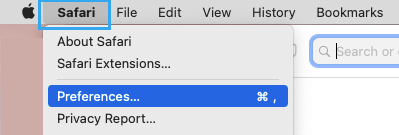
2. On the next screen, switch to Privacy tab and check Always allow option to Enable Cookies on your Mac.
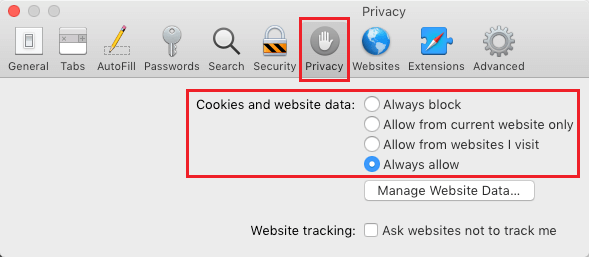
If required, you can Block Cookies at any time on your Mac by selecting Always Block option.
- Related : How to Clear Safari Browsing History on Mac
2. Enable or Disable Cookies in Google Chrome Browser on Mac
If you prefer using Google Chrome browser, you can easily Turn ON or Turn OFF cookies on Mac by following the steps below.
1. Open Google Chrome browser on your Mac > select the Chrome tab in the top-menu bar and click on Preferences… option in the drop-down menu.
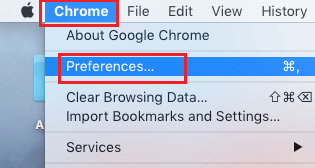
2. On Chrome Settings page, scroll down and click on the Advanced option.

3. Scroll down and click on the Content settings option, located under Privacy and Security section.
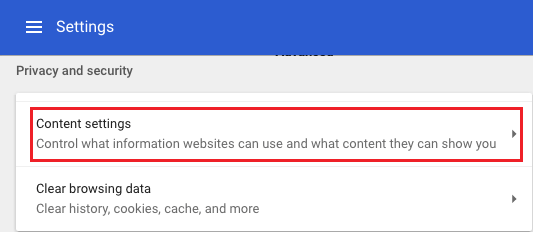
4. Scroll down and click on the Cookies option located under “Content settings” section.
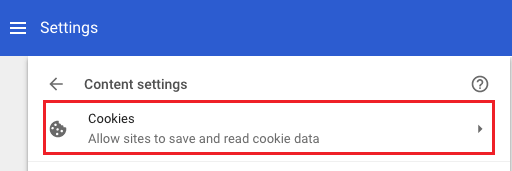
5. On the next screen, toggle ON the option for Allow sites to save and read cookie data (recommended) in order to allow cookies on Mac.
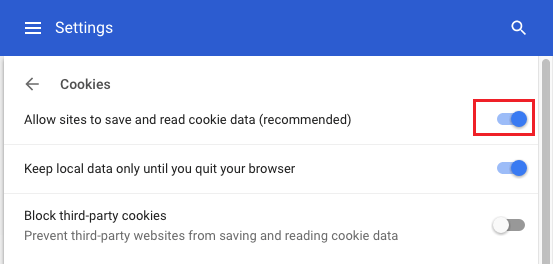
Similarly, you can prevent any website from storing cookies on your Mac by moving “Allow site to save and read cookie data” option to OFF position.
- How to Change Safari File Download Location On Mac
- Stop Autoplaying Videos On Mac in Safari and Chrome Browsers
Blocking cookies from a particular site in Safari on iPad iOS 16.5
Is it possible to block cookies from particular sites in Safari? I didn't see such an option to do so, other than blocking all cookies. Similarly, Chrome on iPad lacks that feature, unlike Chrome on Windows. Thanks.
Posted on May 27, 2023 2:27 PM
Posted on May 29, 2023 7:48 PM
As I understand your question, you want to block specific websites from saving cookies and related website data, but you still want the websites to load and work normally. That's sort of a tall order, and I don't know of an app or Safari Extension that can do that.
I wonder if there is more to your question. Perhaps you simply want to use Private Browsing for those websites?
Browse privately in Safari on Mac - Apple Support
It will not prevent cookies from being stored temporarily (routine website navigation often requires it) but they will be purged along with all other website data upon exiting Private Browsing.
Similar questions
- iPadOS v15.7-How to limit cookies to specific websites? Safari for iPad OS 15.7 appears to only allow blocking or allowing ALL cookies with a toggle on/off switch in Safari Settings. Is there a way to Allow cookies to only a specific website? Thanks in advance. -bob 374 5
- Can I "Whitelist" Cookies in Safari? I was told that the safest way to browse is to block all cookies. Is there a way that I can set Safari to allow cookies that I want while blocking the rest? 480 2
- Cookies aren’t enabled in safari on my iPad? How do I enable cookies in safari on my iPad? Safari is already set to NOT block cookies. One site I try to access with a password continues to say that I have not enabled cookies though. 1883 5
Loading page content
Page content loaded
May 29, 2023 7:48 PM in response to J1-Helena
May 30, 2023 7:03 AM in response to John Galt
Thanks. Chrome on Windows allows you to black/whitelist specific sites to allow/disallow cookies. It doesn’t have that feature on iOS. It’s useful to get around cookies-based paywalls on various sites. I believe there’s a couple apps that may work for this.
May 29, 2023 7:04 PM in response to J1-Helena
Is it possible to block cookies from particular sites in Safari?
No. It's all or nothing.
May 29, 2023 7:28 PM in response to John Galt
Thanks. Do you know of an app that can do this?
Sep 8, 2023 4:52 PM in response to J1-Helena
There's Cookie Viewer in the App Store but I never tested it.
How to Enable Cookies in Any Mac Browser
Is your browser blocking cookies when you don't want it to?
Key Takeaways
- Enabling cookies in your Mac's browser is important for many websites to function properly and store important information.
- Safari users can enable cookies by going to Safari settings, navigating to the Advanced tab, and unchecking the Block all cookies box.
- Other browsers like Chrome, Firefox, and Microsoft Edge also offer options to enable cookies in their privacy settings, allowing for customization and fine control over cookie preferences.
Websites often store small text files on your Mac. While these files, AKA cookies, could raise privacy concerns, many sites will not function properly without them. So, whether you use Safari, Chrome, or Firefox, here's how to enable cookies in your Mac's browser.
While Safari's tracker prevention tool is often best left on, not allowing any cookies can be problematic. Many websites rely on cookies to store important information relating to preferences and account details, and blocking them can create a negative user experience and make some pages slow or completely nonfunctional.
You can enable cookies in Safari using these steps:
- Launch Safari .
- Head to the Advanced tab in the window.
You can also click the Manage Website Data button in the Privacy section of Safari settings to either remove individual cookies you don't want stored on your Mac or clear out all the cookies on Safari. The tool has a search function, so you can easily locate files related to a particular website and delete them if necessary.
Google Chrome
If you use Chrome instead of Safari as the default browser on your Mac, follow these steps to enable cookies:
- Launch Google Chrome .
- Click Chrome in the menu bar and choose Settings .
- Select Privacy and security in the left sidebar.
If you scroll down to the bottom of the same menu, you'll see the option to allow specific sites to use third-party cookies for greater control. Before you alter any settings, you may want to see our guide on Chrome's cookies policy .
Mozilla Firefox
If you're someone who uses Firefox instead of Chrome, you can enable third-party cookies in a similar way by following these simple steps:
- Launch Firefox and click Firefox in the menu bar.
- Select Settings from the dropdown to open up Firefox's settings.
- Click Privacy & Security in the left sidebar.
Firefox also has a tool for blocking or allowing cookies from certain websites. You'll find these settings when you click the Manage Exceptions button under the Cookies and Site Data section in the same menu.
Microsoft Edge
Thanks to the switch to Chromium, Microsoft Edge has gained popularity in recent years. And if you're someone who uses it, here's what you need to do on your Mac to enable cookies on Microsoft Edge:
- Launch Microsoft Edge .
- Click Microsoft Edge in the menu bar and choose Settings .
- Go to Cookies and Site Permissions in the side menu.
- Select Manage and delete cookies and site data on the right.
Further down the page, you'll find a Block and Allow list where you can add specific sites for finer control.
Allow Third-Party Cookies in Less Common macOS Browsers
As you can see, you'll generally find your cookies settings within your browser's privacy settings. If you still can't locate the appropriate setting in your browser, you may need to check the developer's website for more information.
Cookies Are Necessary for Browsing the Web
Cookies aren't necessarily harmful. While many aim to gather personal information and track you across the internet, others are crucial to helping websites work as intended. In fact, cookies help save your preferences, so you don't have to add them each time you visit.
In most cases, you can allow third-party cookies without any serious security risks. Most browsers offer intuitive options within their privacy settings that let you quickly alter and customize your preferences.
Enable Cookies in Safari
Updated at: Feb 19, 2022
This guide will step you through the process of getting Cookies enabled in Safari on macOS.
Enable Cookies
Click the "safari" menu.
Make sure you have a Safari window open and active; you will see the "Safari" menu in the top left of your screen. Click it and it will expand to show Safari specific options.

Click the "Preferences" menu item
Now that you have expanded the Safari menu, you will see the Preferences item - click on it.

The Safari Preferences screen will now appear.
Click the "Privacy" tab
The Safari Preferences screen has a number of sections, indicated by the various options along the top of the screen (General/Tabs/AutoFill etc). Click the Privacy item to see privacy related options.
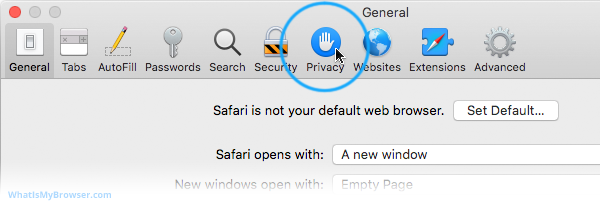
Choose your preferred Cookies and tracking settings
On the Privacy Preferences tab, you will see the " Website tracking: " and " Cookies and website data: " checkboxes.

Enabling Prevent cross-site tracking blocks third-party cookies from being set as well as third-party websites from storing data on your computer. Enabling this option is a good step in helping prevent companies from tracking your activity online.
Enabling Block all cookies will prevent block First-Party cookies, as well as Third-Party cookies. Enabling this may cause websites to not work properly, and Safari will warn you about this if you choose this option.
A good balance of settings is to enable Prevent cross-site tracking and disable Block all cookies .
If you click the Manage Website Data button you'll see a list of website domains which have stored data on your computer. You can remove some or all of them.
Close the Preferences window
Once you have configured your cookie blocking preferences, you can simply close this window and continue using Safari.

Congratulations, you just configured Cookies in Safari. Click here to check if Cookies are enabled.
You may also want to take a moment to clear your cookies and history in Safari .

Safari and Third-Party Cookies
After extensive testing and debugging, we have found that when you enable Block cross-site tracking in Safari it will still hold on to the third-party cookies and keep using them until you restart Safari.
So if you choose to enable Block cross-site tracking in Safari, make sure you restart (and preferably Reset Safari) to ensure that it doesn't keep using any third party cookies it may have cached.
More guides and help for Safari
Need more help with Safari? Read our other Safari guides .
Clear cache & history
Do i need to clear my cache.
Not sure why you've been asked to clear your cache? We can explain. Why you need to clear your cache
What is a cache?
Before you consider clearing your browser cache, you should know what it is! Learn a little bit about browser caches
Is it safe to clear my cache?
Are there any risks to clearing your cache? Find out if it's ok to clear your cache
Update my web browser
Do i need to update my browser.
Find out if your browser is out of date Is my browser out of date?
Why should I update my browser?
There are very good reasons to, find out here! Why update your browser?
Is it free to update Chrome?
Find out about the cost of updating Chrome... Does Chrome cost anything?
What does "Update browser" mean?
What does it actually mean? What does it mean to update your browser
Get help with our guides
How to enable javascript.
Change your JavaScript settings Guide to enabling Javascript
How to enable Cookies
Configure your cookie settings for privacy Guide to enabling cookies
Related articles
I can't log in to a website..
We've got a detailed guide to help you solve login problems How to fix website log in problems
Why do websites use cookies?
Why are cookies useful? Do you need them? What's the deal with cookies?
How to update your browser
Old software puts you at risk. Keep your browser fresh and up to date
Clear Cache, Cookies and History
How to reset your browsing history How to reset your browser
Try a different web browser
Different web browsers have different features - try a different one to see if you prefer it. Experiment a bit!
Use a VPN to hide your IP address
We recommend NordVPN to hide your IP address or to unblock websites. Hide your IP Address
Apple blocks third-party cookies in Safari

Starting today, with the release of Safari 13.1 and through updates to the Intelligent Tracking Prevention (ITP) privacy feature, Apple now blocks all third-party cookies in Safari by default.
The company's move means that online advertisers and analytics firms cannot use browser cookie files anymore to track users as they visit different sites across the internet.
But Apple says the move isn't actually a big deal, since they were already blocking most third-party cookies used for tracking anyway.
"It might seem like a bigger change than it is," said John Wilander, an Apple software engineer. "But we've added so many restrictions to ITP since its initial release in 2017 that we are now at a place where most third-party cookies are already blocked in Safari."
Second browser to block third-party cookies for all users
Apple's Safari has now become the second browser -- after the Tor Browser -- to block all third-party cookies by default for all its users.
However, while Apple was quicker to block third-party cookies in Safari, Google is actually the one who pushed browser makers towards making this move in the first place, in a May 2019 blog post .
At the time, Google announced plans to block third-party cookies by default in Chrome and in the Chromium open-source project, on which multiple other browsers are built.
Google released Chrome v80 at the start of February with support for third-party cookie blocking (under the name of SameSite cookies ), but the feature won't fully roll out to all Chrome's users until 2022 .
Microsoft's Edge, which runs a version of Google's Chromium open-source browser has also begun gradually blocking third-party cookies as well, but the feature is not enabled by default for all its users either.
Apple's decision today doesn't mean that Safari now blocks all user tracking, but only tracking methods that rely on planting a cookie file in Safari and (re-)checking that cookie time and time again to identify the user as he moves from site to site.
Other user tracking solutions, such as user/browser fingerprinting, will most likely continue to work.
A small step forward for web privacy
Nonetheless, this is a major step in the right direction. With Google, Safari, Microsoft, and all the other Chromium-based browsers on board, now, the vast majority of current web browsers block third-party cookies or are on their way towards full blocks.
"This update takes several important steps to fight cross-site tracking and make it more safe to browse the web," Wilander explained in a Twitter thread today .
"First of all, it paves the way. We will report on our experiences of full third-party cookie blocking to the privacy groups in W3C to help other browsers take the leap.
"Second, full third-party cookie blocking removes statefulness in cookie blocking.
"Third, full third-party cookie blocking fully disables login fingerprinting, a problem on the web described already 12 years ago. Without protection, trackers can figure out which websites you're logged in to and use it as a fingerprint," Wilander added.
"Fourth, full third-party cookie blocking solves cross-site request forgeries. This is one of the web's original security vulnerabilities and discussed in communities like OWASP for well over a decade. Those vulnerabilities are now gone in Safari."
More on the move and what it means to developers and website owners is available in the WebKit team's blog post .
All the Chromium-based browsers
The best vpns for iphone and ipad: expert tested, google yet again delays killing third-party cookies in chrome. here's what you need to know, the best mobile vpns: expert tested.
Safari User Guide
- Get started
- Go to a website
- Bookmark webpages to revisit
- See your favorite websites
- Use tabs for webpages
- Import bookmarks and passwords
- Pay with Apple Pay
- Autofill credit card info
- View links from friends
- Keep a Reading List
- Hide ads when reading
- Translate a webpage
- Download items from the web
- Add passes to Wallet
- Save part or all of a webpage
- Print or create a PDF of a webpage
- Interact with text in a picture
- Change your homepage
- Customize a start page
- Get extensions
- Block pop-ups
- Make Safari your default web browser
- Hide your email address
- Manage cookies
- Clear your browsing history
- Browse privately
- Prevent cross-site tracking
- See who tried to track you
- Change Safari settings
- Keyboard and other shortcuts
Clear cookies in Safari on Mac
You can see all the websites that have stored cookies and website data on your Mac, and you can remove some or all of it.
Open Safari for me
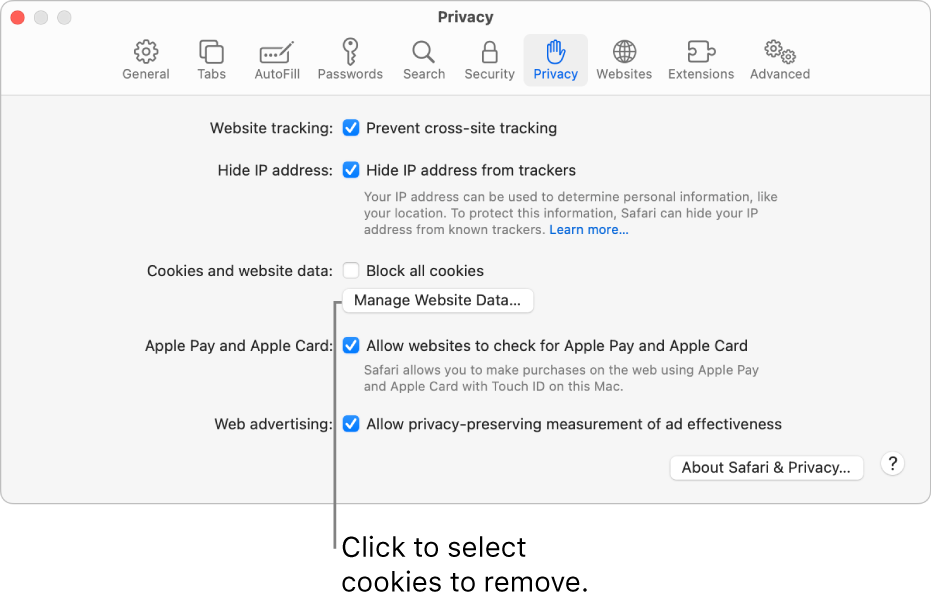
Click Manage Website Data.
Select one or more websites, then click Remove or Remove All.
Removing the data may reduce tracking, but may also log you out of websites or change website behavior.
Note: Removing cookies and website data in Safari may change or remove them in other apps.
Apple updates Safari on iOS and Mac to block third-party cookies
Safari is getting better at protecting you on the web.

Safari is blocking third-party cookies.
Annoyed at how much data companies gather from your web browsing? Apple's giving Safari on iOS and MacOS an update to help.
Announced Tuesday by Apple WebKit engineer John Wilander in a blog post on the WebKit site, the move fully blocks third-party cookies, bringing the latest version of Safari in-line with other browsers like Tor. (WebKit is the browser engine that powers Safari.)
Google said in a blog post of its own earlier this year that it hopes to add similar functionality to Chrome "within two years."
Cookies allow for tracking behavior across websites, something that has been under increasing scrutiny in recent years as the internet community began taking stock of how much data was being collected online by these trackers, known as third-party cookies and often used by social networks and advertising companies. With this new update, the newest Safari will no longer allow those cookies to operate.
In tweets accompanying his blog post, Wilander says that Apple will report back its experience to privacy groups such as the Worldwide Web Consortium to "help other browsers take the leap."
This update takes several important steps to fight cross-site tracking and make it more safe to browse the web. First of all, it paves the way. We will report on our experiences of full third-party cookie blocking to the privacy groups in W3C to help other browsers take the leap. — John Wilander (@johnwilander) March 24, 2020
The move is Apple's latest to fight against data trackers. Last year the company built a new browser technology called Privacy Preserving Ad Click Attribution. It was designed to let advertisers figure out when their ads successfully got you to buy something, but without tracking you across the internet and harvesting personal details to do so.
The company has taken other steps to try and limit the gathering of people's information, including creating Sign In with Apple , a way for people to sign in to apps and websites without having to necessarily divulge personal information such as their actual email address.
The new version of Safari is out now in iOS and iPadOS 13.4 and in Safari version 13.1 on MacOS.
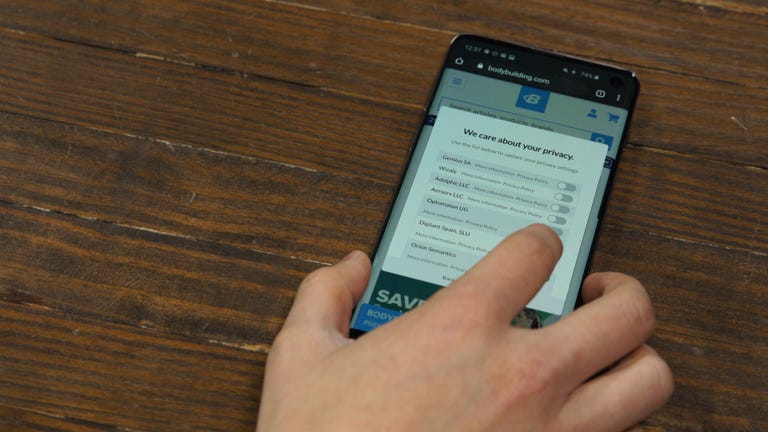
CNET's Stephen Shankland contributed to this report.
Computing Guides
- Best Laptop
- Best Chromebook
- Best Budget Laptop
- Best Cheap Gaming Laptop
- Best 2-in-1 Laptop
- Best Windows Laptop
- Best Macbook
- Best Gaming Laptop
- Best Macbook Deals
- Best Desktop PC
- Best Gaming PC
- Best Monitor Under 200
- Best Desktop Deals
- Best Monitors
- M2 Mac Mini Review
- Best PC Speakers
- Best Printer
- Best External Hard Drive SSD
- Best USB C Hub Docking Station
- Best Keyboard
- Best Webcams
- Best Laptop Backpack
- Best Camera to Buy
- Best Vlogging Camera
- Best Tripod
- Best Waterproof Camera
- Best Action Camera
- Best Camera Bag and Backpack
- Best E-Ink Tablets
- Best iPad Deals
- Best E-Reader
- Best Tablet
- Best Android Tablet
- Best 3D Printer
- Best Budget 3D Printer
- Best 3D Printing Filament
- Best 3D Printer Deals
- Dell Coupon Codes
- Newegg Promo Codes
- HP Coupon Codes
- Microsoft Coupons
- Anker Coupons
- Logitech Promo Codes
- Western Digital Coupons
- Monoprice Promo Codes
- A4C Coupons
How To Enable Cookies In Safari On Mac

- Software & Applications
- Browsers & Extensions

Introduction
Safari, the sleek and intuitive web browser developed by Apple, offers a seamless and secure browsing experience for Mac users. One essential aspect of web browsing involves the use of cookies, which are small pieces of data stored on your computer by websites you visit. These cookies serve various purposes, such as remembering your login information, personalizing your browsing experience, and tracking site usage.
Enabling cookies in Safari on your Mac is a fundamental step to ensure that websites can function optimally and provide you with a tailored and convenient browsing experience. By allowing cookies, you can access personalized content, retain preferences across sessions, and enjoy a smoother interaction with websites you frequently visit.
In this guide, we will walk you through the process of enabling cookies in Safari on your Mac. Whether you're a seasoned Mac user or a newcomer to the platform, understanding how to manage cookies in Safari can significantly enhance your browsing experience. So, let's delve into the step-by-step instructions to empower you with the knowledge and skills to customize your cookie settings in Safari, tailored to your preferences and privacy requirements.
Step 1: Open Safari
To embark on the journey of customizing your cookie settings in Safari, the first step is to open the browser on your Mac. Safari is seamlessly integrated into the macOS ecosystem, offering a user-friendly interface and a range of features designed to optimize your browsing experience.
You can easily launch Safari by clicking on its icon in the Dock, which is typically located at the bottom of the screen. Alternatively, you can access Safari from the Applications folder in Finder. Upon opening the browser, you will be greeted by the familiar Safari window, where you can begin your exploration of the web.
As Safari springs to life, you'll notice the clean and minimalist design that characterizes the browser, reflecting Apple's commitment to simplicity and functionality. The uncluttered interface provides a welcoming environment for users to navigate the web, with a focus on content and intuitive navigation.
Once Safari is open, you're ready to proceed to the next step in customizing your cookie settings. With the browser at your fingertips, you're poised to delve into the realm of Safari preferences, where you can fine-tune various aspects of your browsing experience, including cookie management.
With Safari now open, you're one step closer to unlocking the full potential of your browsing experience. The journey to enable and customize cookies in Safari is just beginning, and the next step will take you deeper into the browser's settings, empowering you to tailor your cookie preferences to suit your individual needs and privacy considerations.
Step 2: Access Safari Preferences
Accessing Safari preferences is the gateway to unlocking a treasure trove of customization options, including the ability to manage cookies according to your preferences and privacy requirements. By delving into the Safari preferences, you gain the power to tailor your browsing experience, ensuring that it aligns with your individual needs and enhances your interaction with websites.
To access Safari preferences, you can simply click on "Safari" in the top menu bar, located next to the Apple logo. A drop-down menu will appear, presenting a range of options, including "Preferences." Clicking on "Preferences" will open a new window dedicated to Safari settings, where you can explore and customize various aspects of the browser's functionality.
Alternatively, you can use the keyboard shortcut "Command + ," to swiftly access Safari preferences, streamlining the process and allowing you to delve into the settings without interrupting your browsing flow.
Upon entering the Safari preferences window, you will be greeted by a series of tabs, each offering a distinct set of customization options. To navigate to the relevant section for managing cookies, you should click on the "Privacy" tab, which is represented by an icon featuring a stylized padlock.
The "Privacy" tab is where the magic happens, as it empowers you to fine-tune your cookie settings and exercise control over how websites interact with your browser. Within this tab, you will find the "Cookies and website data" section, which is pivotal for customizing your cookie preferences.
By clicking on "Cookies and website data," you will unveil a range of options that allow you to manage how Safari handles cookies. This includes the ability to block all cookies, block only third-party cookies, or allow cookies from websites you visit. Additionally, Safari offers the flexibility to customize cookie settings on a per-website basis, granting you granular control over your browsing experience.
As you navigate through the Safari preferences window and immerse yourself in the realm of cookie management, you are empowered to align your browsing habits with your privacy preferences. The ability to access Safari preferences and fine-tune cookie settings underscores Apple's commitment to user empowerment and privacy protection, ensuring that you have the tools to shape your digital footprint according to your values and preferences.
With Safari preferences at your disposal, you are poised to embark on the next phase of the journey, where you will delve into the intricacies of enabling and customizing cookies to optimize your browsing experience. Armed with the knowledge of accessing Safari preferences, you are well-equipped to navigate the digital landscape with confidence and control, harnessing the power to tailor your browsing experience to perfection.
Step 3: Enable Cookies
Enabling cookies in Safari is a straightforward process that empowers you to harness the full potential of your browsing experience. By allowing cookies, you can access personalized content, retain preferences across sessions, and enjoy seamless interactions with websites you frequent. Here's how you can enable cookies in Safari on your Mac:
Navigate to Safari Preferences: As outlined in the previous step, accessing Safari preferences is the gateway to customizing your browsing experience. Click on "Safari" in the top menu bar and select "Preferences" to open the Safari preferences window.
Access the Privacy Tab: Within the Safari preferences window, click on the "Privacy" tab, denoted by an icon featuring a stylized padlock. This tab is where you can manage various aspects of your privacy and security settings, including cookie management.
Enable Cookies: In the "Privacy" tab, locate the "Cookies and website data" section. Here, you will find the option to enable cookies. By default, Safari allows cookies from websites you visit, ensuring that you can benefit from personalized content and a seamless browsing experience.
Customize Cookie Settings: While enabling cookies allows websites to store data on your Mac, Safari provides additional options to customize cookie settings based on your preferences. You can choose to block all cookies or only third-party cookies, offering granular control over your privacy and browsing habits.
Save Your Preferences: After enabling cookies and customizing your settings, you can simply close the Safari preferences window. Your preferences will be automatically saved, ensuring that Safari adheres to your chosen cookie management settings during your browsing sessions.
Enabling cookies in Safari empowers you to unlock a world of personalized content and seamless interactions with websites, tailored to your preferences. By understanding how to enable and customize cookies in Safari, you are equipped to shape your browsing experience according to your individual needs and privacy considerations. With cookies enabled, you can navigate the digital landscape with confidence, knowing that Safari is optimized to deliver a tailored and convenient browsing experience.
As you embark on the journey of enabling cookies in Safari, you are poised to harness the power of personalized content and seamless interactions with websites, enhancing your digital experience and empowering you to navigate the web with ease and confidence.
Step 4: Customize Cookie Settings
Customizing cookie settings in Safari offers a nuanced approach to managing your browsing experience, allowing you to tailor your privacy and preferences with precision. Once you have enabled cookies, Safari provides additional options to customize cookie settings based on your individual needs and browsing habits.
Upon accessing the "Cookies and website data" section within the Safari preferences window, you will encounter a range of customizable options that empower you to fine-tune how Safari handles cookies. These options include:
Block All Cookies: Safari allows you to block all cookies, preventing websites from storing any data on your Mac. While this approach prioritizes privacy and data protection, it may impact certain website functionalities that rely on cookies to deliver personalized content and retain user preferences.
Block Only Third-Party Cookies: This setting enables you to block cookies from third-party websites, while still allowing first-party cookies from the websites you directly visit. By blocking third-party cookies, you can enhance your privacy and mitigate tracking from external sources, while still benefiting from essential website functionalities.
Manage Website Data: Safari offers the flexibility to manage website data on a per-site basis. This granular control allows you to view and modify the specific cookies stored by individual websites, empowering you to make informed decisions about your data preferences for each site you visit.
Remove Stored Cookies and Data: In addition to customizing cookie settings, Safari enables you to remove stored cookies and website data. This feature empowers you to clear accumulated data from your browsing history, ensuring a clean slate and enhanced privacy as you navigate the web.
By customizing cookie settings in Safari, you can align your browsing experience with your privacy preferences, ensuring that your digital footprint reflects your values and priorities. Whether you prioritize stringent data protection or seek a balance between privacy and personalized content, Safari's customizable cookie settings empower you to navigate the web with confidence and control.
As you delve into the realm of customizing cookie settings, you are equipped to shape your digital experience according to your unique preferences, ensuring that Safari aligns with your privacy and browsing habits. With the ability to fine-tune cookie settings, you can navigate the digital landscape with assurance, knowing that your browsing experience is tailored to your individual needs and privacy considerations.
In conclusion, the process of enabling and customizing cookies in Safari on your Mac empowers you to shape your browsing experience according to your individual needs and privacy considerations. By understanding how to manage cookies in Safari, you gain the ability to access personalized content, retain preferences across sessions, and navigate the web with confidence and control.
The journey of enabling cookies in Safari begins with accessing the browser and delving into the realm of Safari preferences. This pivotal step sets the stage for customizing your cookie settings, ensuring that your browsing experience aligns with your privacy preferences and browsing habits. With the ability to access Safari preferences and fine-tune cookie settings, you are well-equipped to navigate the digital landscape with assurance, knowing that your browsing experience is tailored to your individual needs.
Enabling cookies in Safari is a seamless process that unlocks a world of personalized content and seamless interactions with websites. By allowing cookies, you can access tailored content, retain preferences across sessions, and enjoy a smoother interaction with websites you frequent. This foundational step sets the stage for a personalized and convenient browsing experience, tailored to your unique preferences.
Furthermore, customizing cookie settings in Safari offers a nuanced approach to managing your browsing experience, allowing you to tailor your privacy and preferences with precision. Whether you prioritize stringent data protection or seek a balance between privacy and personalized content, Safari's customizable cookie settings empower you to navigate the web with confidence and control.
As you navigate the digital landscape with Safari, the ability to enable and customize cookies underscores Apple's commitment to user empowerment and privacy protection. By providing users with the tools to shape their digital footprint according to their values and preferences, Safari ensures that your browsing experience is aligned with your individual needs and privacy considerations.
In essence, the process of enabling and customizing cookies in Safari on your Mac is not merely a technical task; it is a journey of empowerment and control. By understanding how to manage cookies in Safari, you are poised to navigate the web with confidence, knowing that your browsing experience is tailored to your unique preferences and privacy considerations.
Leave a Reply Cancel reply
Your email address will not be published. Required fields are marked *
Save my name, email, and website in this browser for the next time I comment.
- Crowdfunding
- Cryptocurrency
- Digital Banking
- Digital Payments
- Investments
- Console Gaming
- Mobile Gaming
- VR/AR Gaming
- Gadget Usage
- Gaming Tips
- Online Safety
- Software Tutorials
- Tech Setup & Troubleshooting
- Buyer’s Guides
- Comparative Analysis
- Gadget Reviews
- Service Reviews
- Software Reviews
- Mobile Devices
- PCs & Laptops
- Smart Home Gadgets
- Content Creation Tools
- Digital Photography
- Video & Music Streaming
- Online Security
- Online Services
- Web Hosting
- WiFi & Ethernet
- Browsers & Extensions
- Communication Platforms
- Operating Systems
- Productivity Tools
- AI & Machine Learning
- Cybersecurity
- Emerging Tech
- IoT & Smart Devices
- Virtual & Augmented Reality
- Latest News
- AI Developments
- Fintech Updates
- Gaming News
- New Product Launches
Learn To Convert Scanned Documents Into Editable Text With OCR
Top mini split air conditioner for summer, related post, comfortable and luxurious family life | zero gravity massage chair, when are the halo awards 2024, what is the best halo hair extension, 5 best elegoo mars 3d printer for 2024, 11 amazing flashforge 3d printer creator pro for 2024, 5 amazing formlabs form 2 3d printer for 2024, related posts.

How To Stay Signed In To Google On Safari

Why Won’t Safari Load
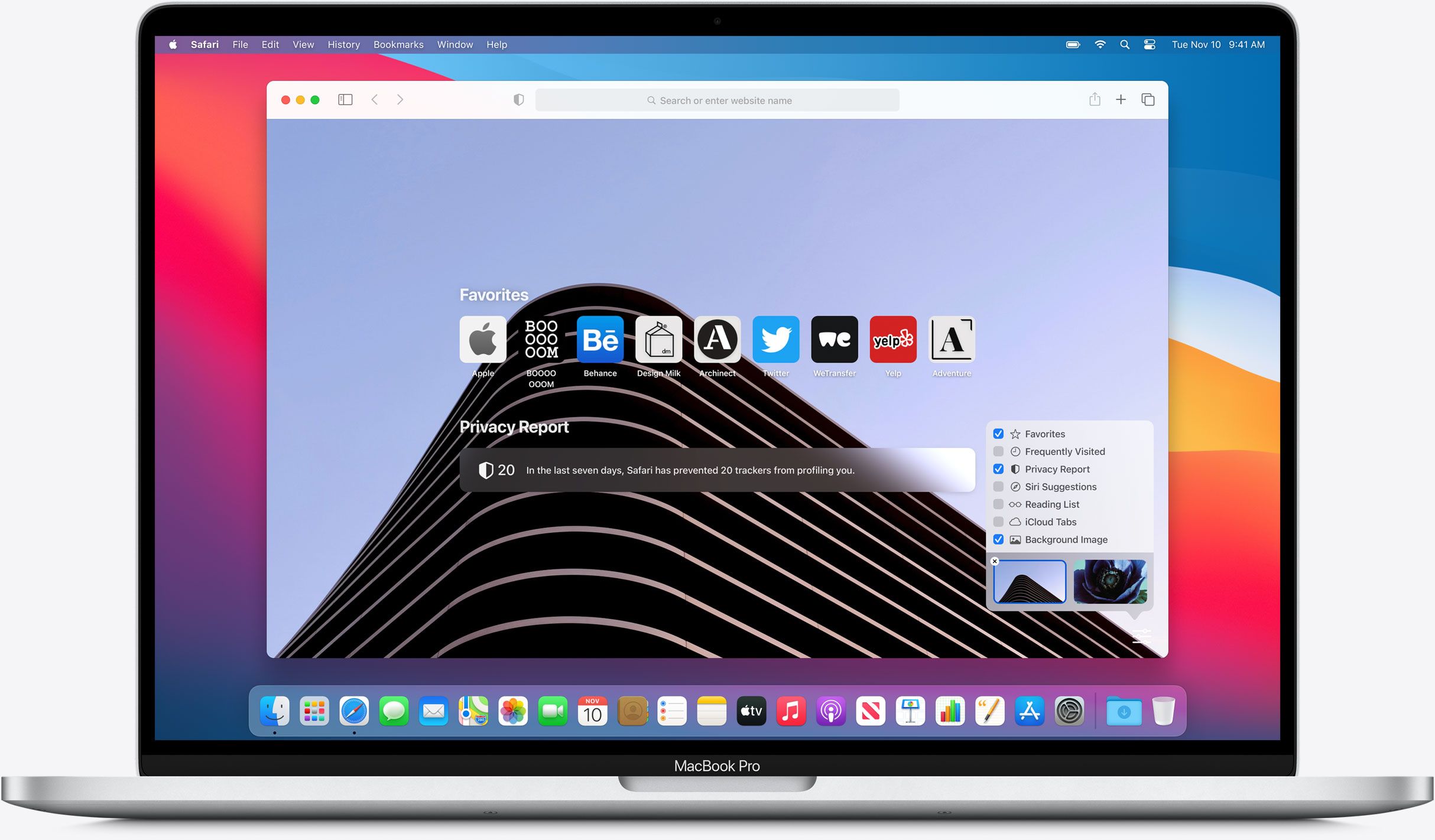
How To Enable Cookies On Safari Browser

How To Clear Cookies In Safari On MacBook

How To Remove Safari Documents And Data
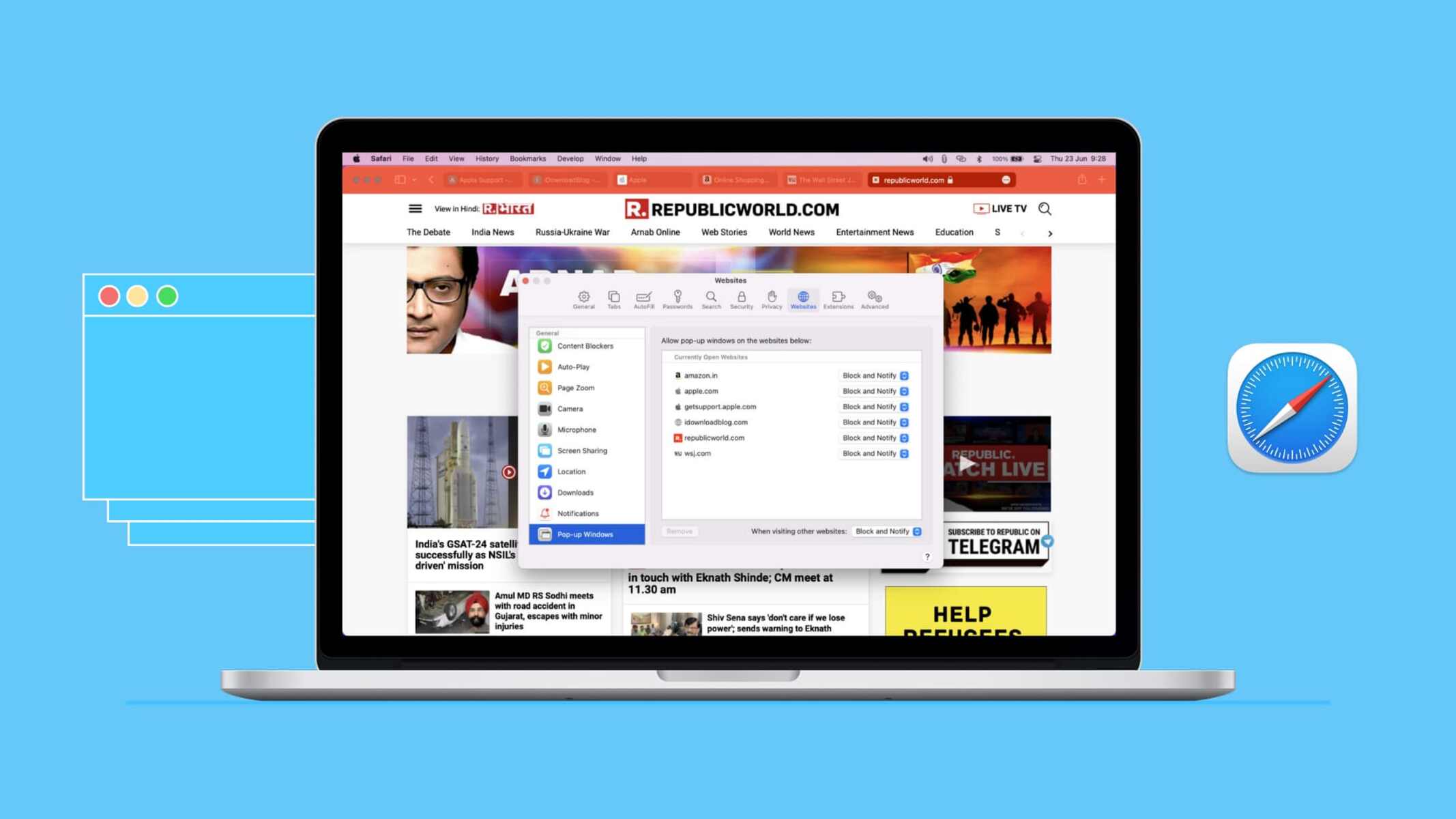
How Do You Enable Cookies On Safari
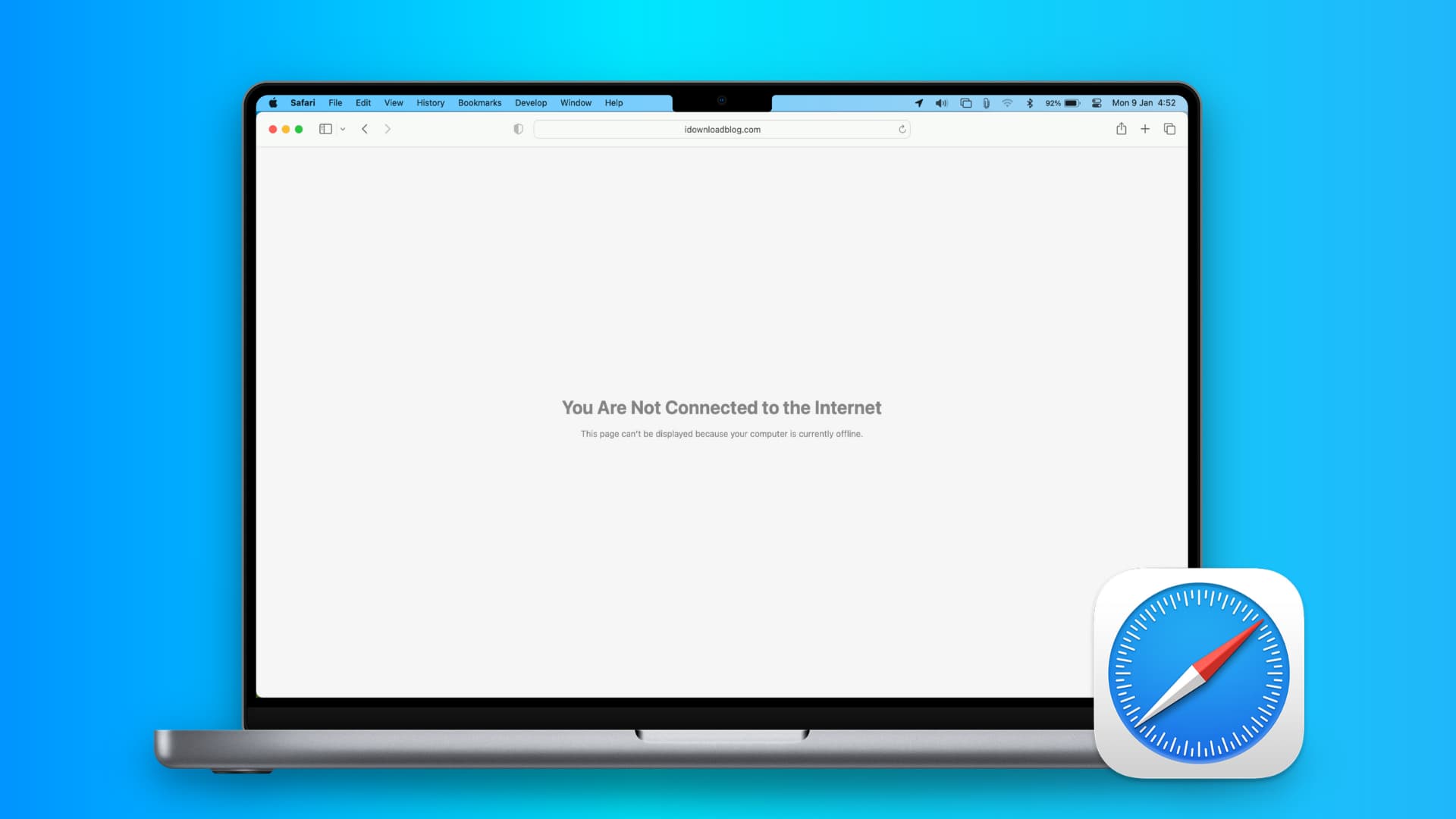
Why Won’t Safari Connect To The Internet
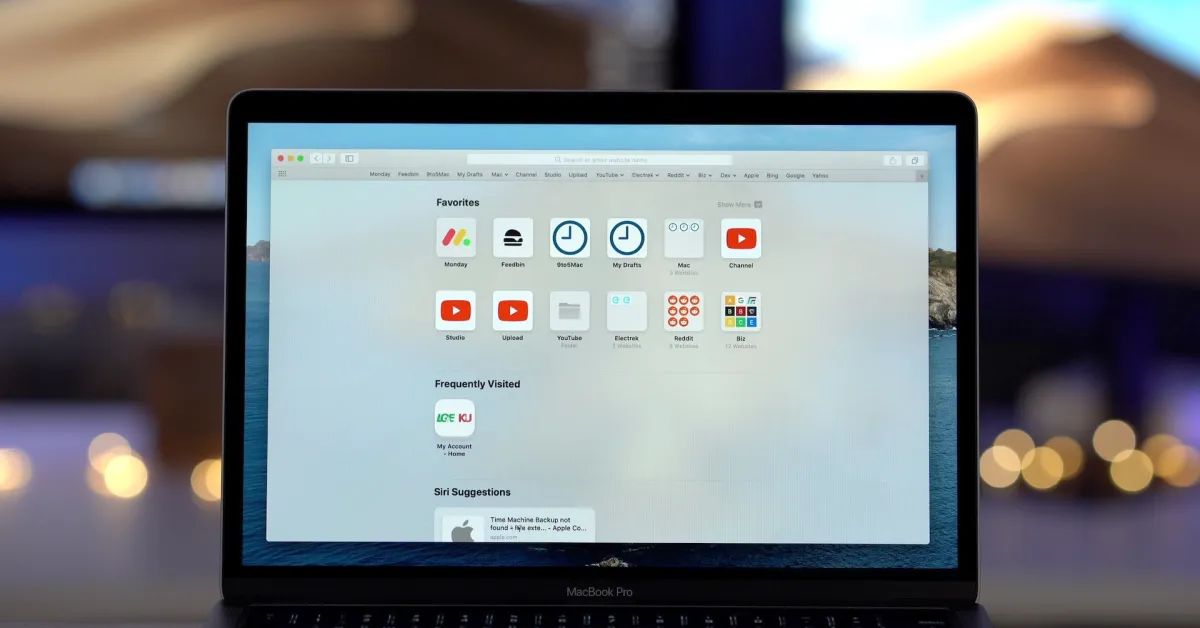
Why Does Safari Not Work On My Mac
Recent stories.

Fintechs and Traditional Banks: Navigating the Future of Financial Services

AI Writing: How It’s Changing the Way We Create Content

How to Find the Best Midjourney Alternative in 2024: A Guide to AI Anime Generators

How to Know When it’s the Right Time to Buy Bitcoin

Unleashing Young Geniuses: How Lingokids Makes Learning a Blast!

- Privacy Overview
- Strictly Necessary Cookies
This website uses cookies so that we can provide you with the best user experience possible. Cookie information is stored in your browser and performs functions such as recognising you when you return to our website and helping our team to understand which sections of the website you find most interesting and useful.
Strictly Necessary Cookie should be enabled at all times so that we can save your preferences for cookie settings.
If you disable this cookie, we will not be able to save your preferences. This means that every time you visit this website you will need to enable or disable cookies again.
iOS Tip: Be Careful When Blocking Safari Cookies

I had a funny little incident over the weekend while using iOS. One night, I decided to control my Safari cookies by having the browser always block cookies. Everything seemed okay at first. Then the next day, I cleared my website history and data. I then found myself unable to log into any website in Safari. I’ll replicate my steps below in case you run into the same issue.

Blocking Safari Cookies
You can block Safari cookies on iOS by going into Settings > Safari > Privacy & Security section. There are four options to choose from: Always Block, Allow from Current Website Only, Allow from Websites I Visit, and Always Allow.
Normally, I use the setting Allow from Current Website Only. This allows first-party cookies and blocks third-party cookies. The difference is that third-party cookies come from trackers and advertisers, while first-party cookies come from the website you actually visit.
Cookies R Us
Cookies aren’t necessarily bad, at least first-party cookies. It’s just a way for your browser to “remember” your settings for a particular website. For example, when I visit Google search, I get an annoying message where Google nudges me to use Chrome.
I press the button to say no, and I never get the pop-up again. This is because Google set a cookie that remembers that I pressed no, so I don’t have to keep pressing it every time I visit Google search. But when you always block cookies, Google shows the window each time, treating each visit as a new session.
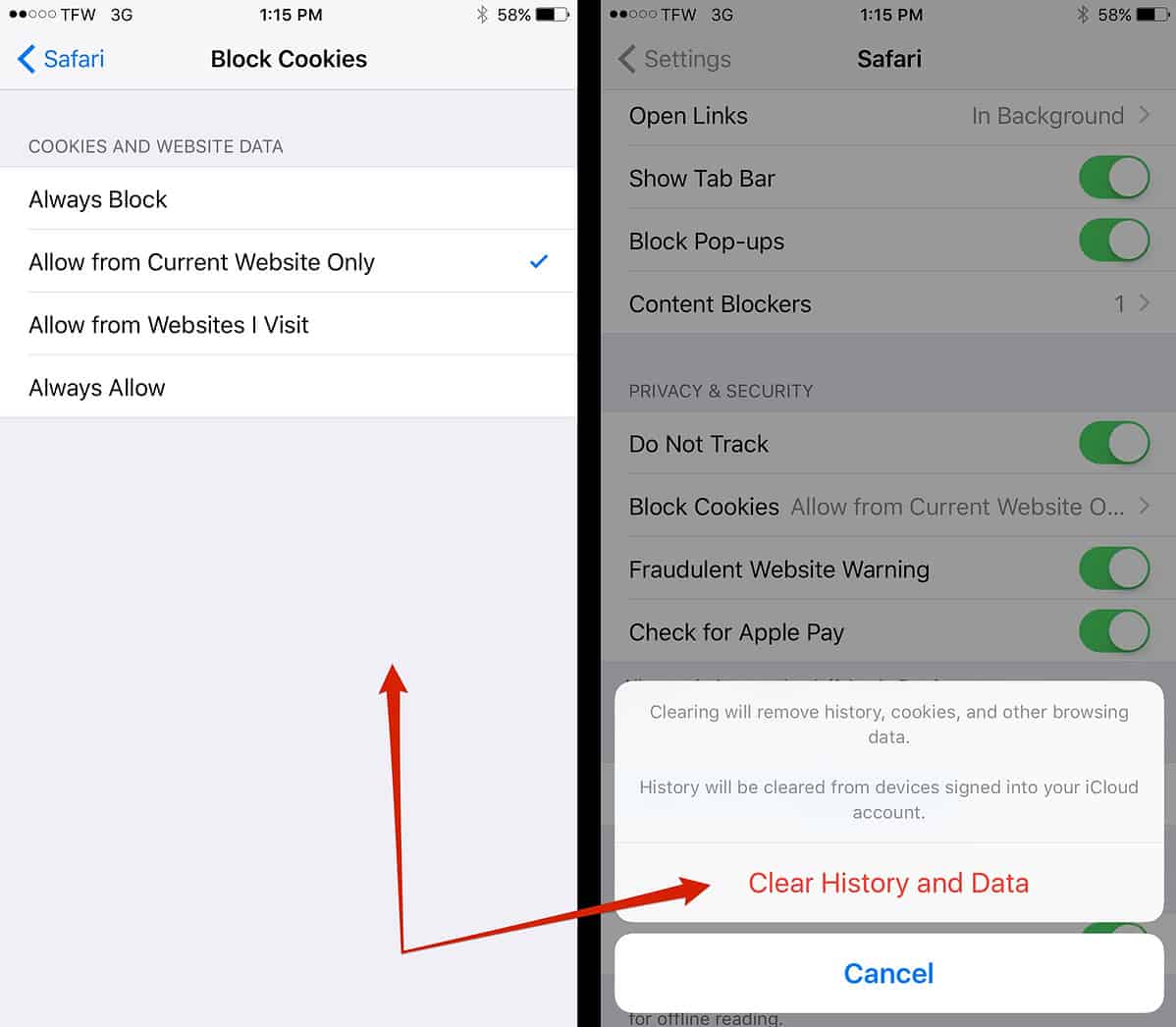
In the same way, when you log into a website, there is often a little button that says “Remember Me.” This is a persistent login cookie that saves your information in the browser, so you don’t have to login each time.
I found an Apple support page where it discusses Safari cookies and the different settings you can use. Under the Always block section, it gives the caveat: “This may prevent some websites from working properly.”
Apparently, not being able to log into websites is an example of improperly working. Maybe if I hadn’t cleared the website data, which includes cookies, I wouldn’t have run into this problem. So my tip is to accept first-party cookies and block third-party cookies.
One thought on “ iOS Tip: Be Careful When Blocking Safari Cookies ”
“So my tip is to accept first-party cookies and block third-party cookies.”
Any tips for webside coders?
Leave a Reply Cancel reply
You must be logged in to post a comment.
This site uses Akismet to reduce spam. Learn how your comment data is processed .
- Apple Pencil
- Apple Watch
- All Smart TVs
In This Article
Does safari support third-party cookies, how do i allow third-party cookies on safari, how do i stop safari from blocking third-party cookies, related articles, enable third-party cookies on safari [mac – iphone – ipad].
Updated on: February 08, 2024
First of all, what are third-Party cookies?
Third-party cookies are created by websites other than the one you are visiting. As the name suggests (third-party), they are made by external parties focused on advertising, retargeting, and providing tracking services .
Like standard cookies, third-party cookies store information about the user that the domain that collects them can use later.
Unlike first-party cookies, which try to improve the user experience on the web, third-party cookies are focused on enhancing online marketing, primarily through image advertising. They save user information that includes: gender, age, and user behavior (to determine things like what the users favor and what they avoid.)
The cookies present personalized ads that promote online marketing campaigns based on the user information collected. You can decide whether enable third-party cookies on your web browser or block them.
In this article, you will learn how to enable third-party cookies on Safari .
Safari is one of the most prominent web browsers currently in use. It is the default web browser for Apple devices. For security reasons, third-party cookies are blocked on Safari by default.
However, you can enable third-party cookies on Safari by following a few simple steps on any of your Apple devices. Whether you have a MacBook, an iPhone, or an iPad, let’s talk about enabling the cookies.
Here are the steps to enable third-party cookies on Safari. IOS (iPhone and iPad) settings are the same because they share the same operating system.
Allow Third-party Cookies On Mac
Launch the Safari browser by clicking its icon (it looks like a blue compass).
Click “Safari ”, which is next to the Apple icon.
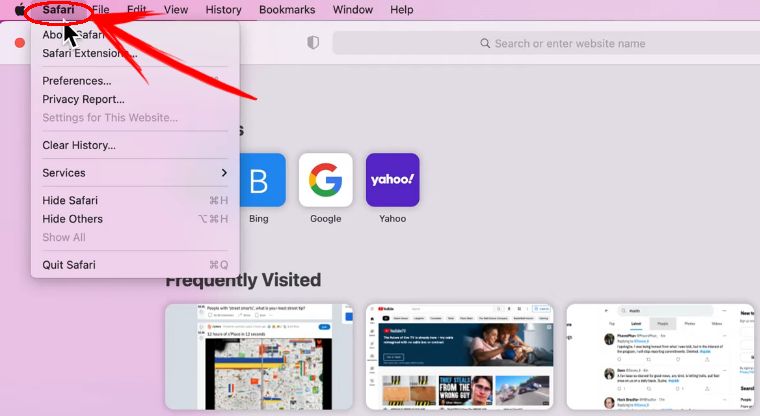
A dropdown menu will appear from which you can select “Preferences” .

Click the “Privacy” tab, which is in the top panel.

Navigate to “Cookies and Website Data” and un-tick the option “Block all cookies” . This will allow 3rd party cookies on Safari.

Allow Third-Party Cookies on iPhone/iPad iOS 11
Go to “Settings” .

Scroll down to “ Safari ” and click on it.

Under “Privacy and Security” turn off “Prevent Cross-Site Tracking ”. Also, turn off “Block All Cookies” (Turning off makes the green bar go white.)
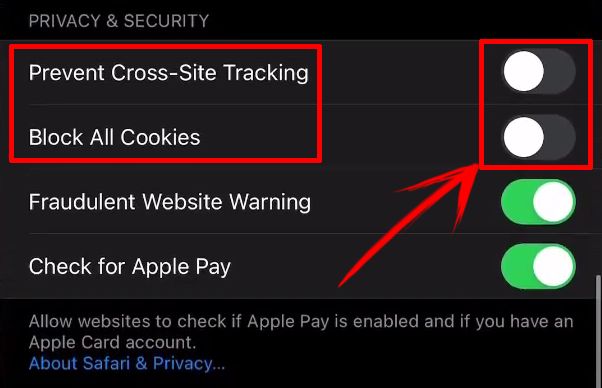
Do you know you can also use Safari to do reverse image search on Mac ?
Allow Third Party Cookies on iPad iOS 10 and others
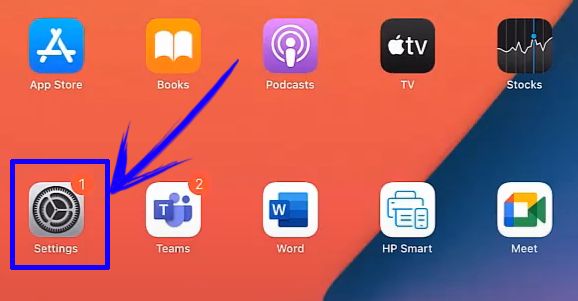
Scroll down to Safari and click on it.

Under “Privacy and Security”, click on “ Block All Cookies ” .
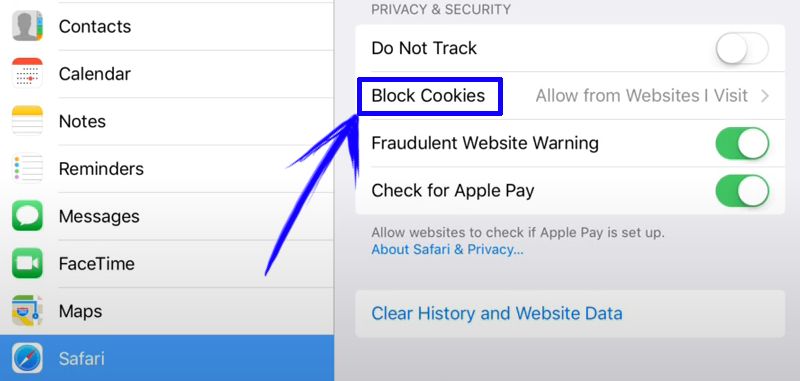
Select “Always Allow” or “Allow from Websites I Visit” from the dropdown menu. This will allow 3rd party cookies on Safari.

Safari is set to block third-party cookies automatically. However, if you use a MacBook and need the browser to stop blocking third-party cookies, you can follow the steps mentioned above to enable third-party cookies on Safari.
At step five, deselect the option “Block Cookies” under the cookies and website data. However, this option allows cookies from all websites to be displayed, which might disrupt your browsing experience.
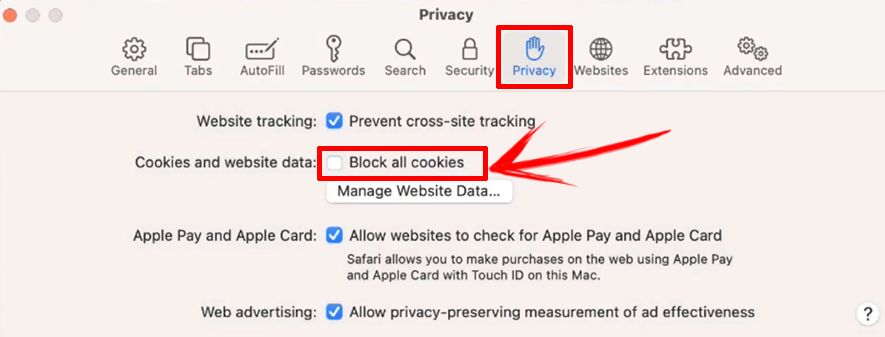
To cut down the number of websites that display cookies, you can check the option “Allow from websites I visit.” With this option, Safari won’t be able to block third-party cookies on the websites you visit frequently with this option enabled, allowing you to browse uninterrupted and conveniently.
- Change Privacy preferences in Safari on Mac
- Manage Cookies and Website Data in Safari on Mac
- 9+ Best Web Browsers for Mac
- Best Web Browsers for Apple TV
- Change Default Browser in Windows 11
- Best Database Software For Mac
Kimanthi Sammy
Kimanthi Sammy is a tech enthusiast and writer passionate about web development, design, video games, software, and tech in general. She combines creativity with technical prowess to produce captivating and informative content.
Don’t Miss…
![Chrome Extensions on iPad - How to Use Them [The Only Way] chrome extensions ipad share](https://alvarotrigo.com/blog/wp-content/uploads/2023/08/chrome-extensions-ipad-share-300x150.png)
- Legal Notice
- Terms & Conditions
- Privacy Policy
A project by Alvaro Trigo

IMAGES
VIDEO
COMMENTS
Always allow cookies: Deselect "Block all cookies.". Websites, third parties, and advertisers can store cookies and other data on your Mac. Remove stored cookies and data: Click Manage Website Data, select one or more websites, then click Remove or Remove All. Removing the data may reduce tracking, but may also log you out of websites or ...
Manage Safari cookies for Apple devices. You can manage how cookies are handled in Safari. You can set the restriction to Always Allow or one of these options: Prevent cross-site tracking. Block all cookies. User action. Enabled. Enabled. Can't disable either setting.
Always block: Safari doesn't let any websites, third parties, or advertisers store cookies and other data on your Mac. This may prevent some websites from working properly. Allow from current website only: Safari accepts cookies and website data only from the website you're currently visiting. Websites often have embedded content from other ...
Cleaning cookies and the cache data for individual sites can be done via Safari's Settings/Preferences. Open Safari. Click on Safari in the menu at the top of the screen. Click on Settings or ...
Delete cookies on iOS. And on iOS, you can delete all your Safari browser cookies by going to Settings > Safari, and then tap the option to Clear history and website data. To delete specific cookies, scroll down and tap Advanced, then Website Data. Type in the search field, then swipe to delete an entry.
Block Cookies in Safari on the Mac. 1. Select Preferences from the Safari menu or use the Command+, keyboard shortcut (hold down the Command key and the comma key at the same time). 2.
Enabling Cookies on a Mac. Download Article. 1. Open Safari and click the Safari menu. While Safari is open, you'll see the "Safari" menu at the top of your Mac's screen. [1] 2. Click Preferences…. This option is near the top of the menu.
1. Open your Safari web browser. 2. On the left side of the toolbar at the very top of your screen, click Safari and select Preferences in the drop-down. Under "Safari," click "Preferences." Grace ...
Apple on Tuesday released a major update to its Safari Intelligent Tracking Prevention (ITP), the privacy feature that allows the company's web browser to block cookies and prevent advertisers ...
How to Enable Cookies in Safari . Safari is Apple's default browser on all Mac computers and iOS devices. To enable cookies on your Mac, start by opening Safari. ... Clear the check mark in front of Block all cookies to enable cookies in Safari. Want to remove specific websites from the list of websites storing your information?
While, enabling Cookies makes your most frequently visited websites to load faster, you may find the need to disable cookies for certain websites on your Mac. If any website appears to be suspicious or harmful, you can Disable Cookies to protect your privacy and personal data in Facebook.
Content blockers are third-party apps and extensions that let Safari block cookies, images, resources, pop-ups, and other content. To get a content blocker: Download a content blocking app from the App Store. ... by Apple, or independent websites not controlled or tested by Apple, is provided without recommendation or endorsement. Apple assumes ...
May 30, 2023 7:03 AM in response to John Galt. Thanks. Chrome on Windows allows you to black/whitelist specific sites to allow/disallow cookies. It doesn't have that feature on iOS. It's useful to get around cookies-based paywalls on various sites. I believe there's a couple apps that may work for this. John Galt.
Safari users can enable cookies by going to Safari settings, navigating to the Advanced tab, and unchecking the Block all cookies box. Other browsers like Chrome, Firefox, and Microsoft Edge also offer options to enable cookies in their privacy settings, allowing for customization and fine control over cookie preferences.
Enable Cookies in Safari. Updated at: Feb 19, 2022. This guide will step you through the process of getting Cookies enabled in Safari on macOS. Enable Cookies. Click the "Safari" menu. Make sure you have a Safari window open and active; you will see the "Safari" menu in the top left of your screen. Click it and it will expand to show Safari ...
Starting today, with the release of Safari 13.1 and through updates to the Intelligent Tracking Prevention (ITP) privacy feature, Apple now blocks all third-party cookies in Safari by default. The ...
Cookies and website data are deleted unless you visit and interact with the trackers' websites. Always block cookies: Select "Block all cookies". Websites, third parties and advertisers can't store cookies and other data on your Mac. This may prevent some websites from working properly. Always allow cookies: Deselect "Block all ...
By Matthew Humphries. March 25, 2020. There's increasing calls for privacy online, and Apple has reacted by making Safari the first mainstream browser to block all third-party cookies by default ...
In Safari on your Mac, clear cookies and website data for some or all websites.
Apple's giving Safari on iOS and MacOS an update to help. Announced Tuesday by Apple WebKit engineer John Wilander in a blog post on the WebKit site, the move fully blocks third-party cookies ...
Block All Cookies: Safari allows you to block all cookies, preventing websites from storing any data on your Mac. While this approach prioritizes privacy and data protection, it may impact certain website functionalities that rely on cookies to deliver personalized content and retain user preferences.
I found an Apple support page where it discusses Safari cookies and the different settings you can use. Under the Always block section, it gives the caveat: "This may prevent some websites from ...
Safari is set to block third-party cookies automatically. However, if you use a MacBook and need the browser to stop blocking third-party cookies, you can follow the steps mentioned above to enable third-party cookies on Safari. At step five, deselect the option "Block Cookies" under the cookies and website data.